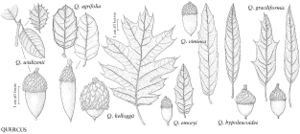Difference between revisions of "Quercus agrifolia"
Anales Ci. Nat. 3: 271. 1801.
FNA>Volume Importer |
FNA>Volume Importer |
||
| Line 30: | Line 30: | ||
}}<!-- | }}<!-- | ||
| − | --><span class="statement" id="st- | + | --><span class="statement" id="st-undefined" data-properties=""><b>Trees,</b> evergreen, to 25 m. <b>Bark</b> gray to dark brown or black, ridges broad, rounded. <b>Twigs</b> brown to red-brown, 1.5-3 mm diam., with scattered pubescence or uniformly pubescent. <b>Terminal</b> buds light chestnut brown, ovoid, occasionally subconic, 3-6(-7) mm, glabrous except for cilia along scale margins. <b>Leaves</b>: petiole 4-15(-18) mm, sparsely to densely pubescent. <b>Leaf</b> blade broadly elliptic to ovate or oblong, 15-75 × 10-40 mm, base rounded or cordate, margins entire or spinose, with up to 24 awns, apex blunt to attenuate; surfaces abaxially glabrous or with small axillary tufts of tomentum, veins raised, adaxially distinctly convex, rugose, glabrous, occasionally densely uniformly pubescent. <b>Acorns</b> annual; cup turbinate to cup- or bowl-shaped, rarely saucer-shaped, 9-13 mm high × 9-15 mm wide, covering 1/4-1/3(-1/2) nut, outer surface glabrous to sparsely puberulent, inner surface pubescent on innermost 1/3 to uniformly pubescent, scales acute, tips loose; nut ovoid to oblong or conic, 15-35 × 10-15 mm, glabrous, scar diam. 3.5-8 mm. <b>2n</b> = 24.</span><!-- |
-->{{Treatment/Body | -->{{Treatment/Body | ||
| Line 36: | Line 36: | ||
|habitat=Moderately dry sites | |habitat=Moderately dry sites | ||
|elevation=to 1400 m | |elevation=to 1400 m | ||
| − | |distribution=Calif.;Mexico (Baja California) | + | |distribution=Calif.;Mexico (Baja California). |
|discussion=<p>Quercus agrifolia is found in the Coast Ranges from Sonoma County, California, south to Baja California. Plants with densely pubescent leaves, especially abaxially, have been treated as Q. agrifolia var. oxyadenia.</p><!-- | |discussion=<p>Quercus agrifolia is found in the Coast Ranges from Sonoma County, California, south to Baja California. Plants with densely pubescent leaves, especially abaxially, have been treated as Q. agrifolia var. oxyadenia.</p><!-- | ||
--><p>This species reportedly hybridizes with Quercus kelloggii and Q. wislizenii.</p><!-- | --><p>This species reportedly hybridizes with Quercus kelloggii and Q. wislizenii.</p><!-- | ||
| Line 58: | Line 58: | ||
|habitat=Moderately dry sites | |habitat=Moderately dry sites | ||
|elevation=to 1400 m | |elevation=to 1400 m | ||
| − | |distribution=Calif.;Mexico (Baja California) | + | |distribution=Calif.;Mexico (Baja California). |
|reference=None | |reference=None | ||
|publication title=Anales Ci. Nat. | |publication title=Anales Ci. Nat. | ||
|publication year=1801 | |publication year=1801 | ||
|special status=Selected by author to be illustrated | |special status=Selected by author to be illustrated | ||
| − | |source xml=https://jpend@bitbucket.org/aafc-mbb/fna- | + | |source xml=https://jpend@bitbucket.org/aafc-mbb/fna-data-curation.git/src/9216fc802291cd3df363fd52122300479582ede7/coarse_grained_fna_xml/V3/V3_368.xml |
|genus=Quercus | |genus=Quercus | ||
|section=Quercus sect. Lobatae | |section=Quercus sect. Lobatae | ||
|species=Quercus agrifolia | |species=Quercus agrifolia | ||
| − | |||
| − | |||
| − | |||
| − | |||
| − | |||
| − | |||
| − | |||
| − | |||
| − | |||
| − | |||
| − | |||
| − | |||
| − | |||
| − | |||
| − | |||
| − | |||
| − | |||
| − | |||
| − | |||
| − | |||
| − | |||
| − | |||
| − | |||
| − | |||
| − | |||
| − | |||
| − | |||
| − | |||
| − | |||
| − | |||
| − | |||
| − | |||
| − | |||
| − | |||
| − | |||
| − | |||
| − | |||
| − | |||
| − | |||
| − | |||
| − | |||
| − | |||
| − | |||
| − | |||
| − | |||
| − | |||
| − | |||
}}<!-- | }}<!-- | ||
-->[[Category:Treatment]][[Category:Quercus sect. Lobatae]] | -->[[Category:Treatment]][[Category:Quercus sect. Lobatae]] | ||
Revision as of 13:39, 27 July 2019
Trees, evergreen, to 25 m. Bark gray to dark brown or black, ridges broad, rounded. Twigs brown to red-brown, 1.5-3 mm diam., with scattered pubescence or uniformly pubescent. Terminal buds light chestnut brown, ovoid, occasionally subconic, 3-6(-7) mm, glabrous except for cilia along scale margins. Leaves: petiole 4-15(-18) mm, sparsely to densely pubescent. Leaf blade broadly elliptic to ovate or oblong, 15-75 × 10-40 mm, base rounded or cordate, margins entire or spinose, with up to 24 awns, apex blunt to attenuate; surfaces abaxially glabrous or with small axillary tufts of tomentum, veins raised, adaxially distinctly convex, rugose, glabrous, occasionally densely uniformly pubescent. Acorns annual; cup turbinate to cup- or bowl-shaped, rarely saucer-shaped, 9-13 mm high × 9-15 mm wide, covering 1/4-1/3(-1/2) nut, outer surface glabrous to sparsely puberulent, inner surface pubescent on innermost 1/3 to uniformly pubescent, scales acute, tips loose; nut ovoid to oblong or conic, 15-35 × 10-15 mm, glabrous, scar diam. 3.5-8 mm. 2n = 24.
Phenology: Flowering early to mid spring.
Habitat: Moderately dry sites
Elevation: to 1400 m
Distribution

Calif., Mexico (Baja California).
Discussion
Quercus agrifolia is found in the Coast Ranges from Sonoma County, California, south to Baja California. Plants with densely pubescent leaves, especially abaxially, have been treated as Q. agrifolia var. oxyadenia.
This species reportedly hybridizes with Quercus kelloggii and Q. wislizenii.
The Mahuna used Quercus agrifolia medicinally to heal the bleeding navel of a newborn (D. E. Moerman 1986).
Selected References
None.
